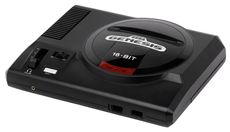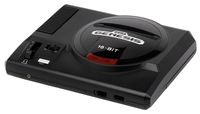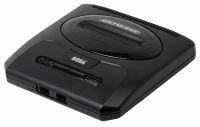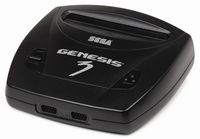Sega Mega Drive/Genesis

|
| Manufacturer
|
SEGA
|
| Generation
|
Fourth generation
|
| Release date
|
October 29, 1988 (JP)
August 14, 1989 (NA)
November 30, 1990 (PAL)
|
| Media type
|
ROM cartridge
|
| Input controller
|
2 controller ports
|
| Predecessor
|
Sega Master System
|
| Successor
|
Sega Saturn
|
The Sega Genesis is a home video game console released on October 29, 1988 by Sega as the Mega Drive (メガドライブ Mega Doraibu), the name it is known as outside North America. The reason for the two names is that Sega was unable to secure legal rights to the Mega Drive name in North America. As a fourth-generation console, the Sega Genesis is Sega's third console and the successor to the Sega Master System with which it has backward compatibility when the separately sold Power Base Converter is installed.
The Sega Genesis was the first of its generation to achieve notable market share in continental Europe and North America with an initial MSRP of $299.99, where it competed against a wide range of platforms, including both dedicated gaming consoles and home computer systems. Two years later, Nintendo released the Super Nintendo Entertainment System, and the competition between the two would dominate the 16-bit era of video gaming. The console began production in Japan in 1988 and ended with the last new licensed game being released in 2002 in Brazil.
Technical specifications[edit]
| Processor:
|
Motorola 68000 16/32-bit processor @ 7.67 MHz
|
| Co-processor:
|
Zilog Z80 8-bit @ 3.58 MHz
|
| Video display processor:
|
Yamaha YM7101
|
| Memory:
|
64kB work RAM (68000), 64kB video RAM, 8kB work RAM (Z80)
|
| Display palette:
|
512 colors (normal) or 1536 (shadow/highlight mode)
|
| Onscreen colors:
|
64 (normal) or 183 (shadow/highlight mode)
|
| Maximum onscreen sprites:
|
80 (320-pixel wide display) or 64 (256-pixel wide display)
|
| Resolution:
|
256×224, 256×448, 320×224, 320×448, (PAL and NTSC)
256×240, 256×480, 320×240, 320×480 (PAL only), 256×192 (SMS games only)
|
| Sound:
|
Yamaha YM2612 5 channel FM and 1 channel FM/PCM, Texas Instruments SN76489 4 channel PSG (Programmable Sound Generator)
|
Hardware variations[edit]
Over its lifetime, the Genesis came in three different models, each of which had several motherboard revisions. For more details, see Sega Genesis Hardware.
| Sega Mega Drive/Genesis Model 1 differences
|
| Country |
Particularities
|
| Japan |
- Japanese-language settings
- Headphone jack
- AUX port marked A/V OUT
- 9-pin EXT. port
- RF modulator
- Has a cartridge lock
- On the circular molding, in purple is the text "AV Intelligent Terminal High Grade Multipurpose Use". At the bottom of the circle is a purple square section with a red power indicator LED.
- "Mega Drive" is printed in white on the lower right of the console to the left of the Sega logo.
- The reset button and start button on the joypad are blue.
- Early models have a small registered trademark icon (®) just to the right of the Sega logo to the lower right of the system.
- Model number HAA-2510
- Word "Tymakz" Printed under the cooling fan.
|
| Europe, Australia & New Zealand |
- Video outputs PAL 50 Hz signal.
- Smaller "16 BIT" logo than Japanese model, as per the Genesis.
- English-language settings.
- Unable to play Japanese Mega Drive games due to shape of cartridge slot. However, adapters were sold to play Japanese games in the European model, and by widening the cartridge slot it is possible to play many import games with no additional modifications, especially with the earlier games.
- Cartridge lock removed.
- The text "High Definition Graphics · Stereo Sound" located behind cartridge port (only found on earlier models).
- The reset button and the start button are white.
- Model number 1600-03 (original model), 1601-03 (second variation without "High Definition Graphics - Stereo Sound" text or EXT port)
|
North America (as Sega Genesis)  |
- AUX port marked A/V OUT
- Headphone jack with volume slider (adjusts audio volume output to headphones only, not A/V OUT)
- 9-pin EXT. port on early models
- Reset and start buttons are gray
- "SEGA GENESIS" graphic in light gray on top of machine below cartridge slot
- "HIGH DEFINITION GRAPHICS" along circle above cartridge slot, and "SEGA GENESIS" graphic in two shades of gray, on early models.
- Model number MK-1601 is made in Japan, newer revisions were made in Taiwan to cut production costs
- Are considered to have the best audio output of any version of the Genesis.
|
| Asia |
- "AV INTELLIGENT TERMINAL HIGH GRADE MULTIPURPOSE USE" printed around circle on some models, omitted on others.
- Larger "16-Bit" logo used as per Japanese model.
- Power panel magenta instead of white.
- "Start" and "Reset" button are blue
- Identical to European Mega Drive with PAL or NTSC output
- Used Japanese Mega Drive logo and packaging similar to the Japanese version
- Registered trademark icon to the right of the Sega logo for earlier models
- Games packaged the same as European with the same labeling. However, the cartridges are shaped like Japanese Mega Drive games.
- Both Pal and NTSC versions available in Asia models
- Model number: 1601-15 (revision without the EXT port)
- Not region locked.
|
|
|
|
| Sega Mega Drive/Genesis Model 2 differences
|
| Country |
Particularities
|
| Japan |
- New square shape
- No headphone jack
- One custom multi-output for picture and sound (9-pin mini-DIN connector rather than the 8-pin DIN connector on the original model)
- Purple colored flaps on cartridge port
- The text "High Grade Multi Purpose Intelligent Terminal" located behind cartridge port.
- Packaged with six-button controller.
- No power LED
- Slide power switch
- Model number HAA-2502
|
| Europe, Australia & New Zealand |
- New square shape
- No headphone jack
- A/V port switched to one custom multi-output for picture and sound (previously, only mono sound was used, as the stereo sound came through the headphone jack)
- Push-button power switch
- Smaller power connector and different AC adapter used
- RF modulator removed
- Has a red power LED between the power and reset buttons
- Auto-switching RF lead included
- Model number MK-1631-50
|
North America (as Sega Genesis)  |
- New square shape
- No headphone jack
- One custom multi-output for picture and sound (stereo)
- Has a red power LED between the power and reset buttons
- "Genesis" logo printed in the area above the cartridge slot
- Model number MK-1631
|
|
|
|
| Sega Genesis Model 3 differences
|
| Particularities
|
 - The model 3 was released exclusively to North America in 1998 as a "budget system", and sold for $50 with many features removed for cutting costs.
- Smaller square shape
- No expansion port
- No headphone jack
- No power LED, but there is a red mark underneath the power switch, which becomes visible when the Genesis 3 is turned on
- One multi-output for picture and sound. It has the necessary pin outs to be able to use the Genesis 2 Stereo A/V cable; though an apparent revision of the Genesis 3 was manufactured that is incompatible with stereo sound, despite also having the pin-outs
- Does not support Sega CD, Sega 32X or Power Base Converter
- "Sega Genesis 3" written below cartridge slot
- Model number MK-1461
- Does not support Game Genie device
- In addition, Japanese Mega Drive cartridges (which do not contain an internal region lockout) can be played without a converter or modification, as the cartridge slot, which is the same shape as the original Japanese console, allows for these cartridges to be inserted freely.
- Has compatibility issues with virtua racing.
- An addressing bug was fixed with the genesis 3, which makes it incompatible with games that exploit this bug.
|
Sega CD combo units[edit]
They consisted of a Mega Drive/Genesis with the Mega-CD addon.
- Released on April 1, 1992 only in Japan, as a combination Mega Drive/Mega-CD player with enhanced sound, video and karaoke capabilities and a mechanized CD tray lid. Also included MIDI functionality. Sega themselves released on April 24, 1992 a variation of this unit with slight cosmetic changes, but functionality remains identical, branded as Sega Wondermega)
- JVC Wondermega Model RG M2
- A second model (Japan exclusive as the first) with a different case design and wireless controller functionality built in. The mechanized CD tray was omitted in favor of a more conventional spring-loaded tray design. Otherwise, functionally identical to the Wondermega I. This model was stripped down released in the US as the JVC X'Eye.)
Power supply[edit]
Model 1 US[edit]
There are a few different types of power supplies for the model 1. The important distinction is the output voltage: some provide 9V, others 10V. Beyond that, they differ by input wattage, which does not matter to the functionality of the console and only affets power consumption. Check the voltage rating printed on the bottom of the model 1 for the correct voltage before using a power supply you find in the wild.
| Power specifications
|
| Model |
1602
|
| Input |
120V AC 60Hz 35W (or 17W)
|
| Output |
9V DC 1.2A
|
| Polarity |
Outside: +
Inside: -
|
| Model |
1602-1
|
| Input |
120V AC 60Hz 20W
|
| Output |
10V DC 1.2A
|
| Polarity |
Outside: +
Inside: -
|
Model 2 US[edit]
| Power specifications
|
| Input |
120V AC 60Hz 15W
|
| Output |
10V DC 0.85A
|
| Polarity |
Outside: -
Inside: +
|
Add-ons[edit]
Sega CD[edit]
- Main article: Sega CD
The Sega CD (Mega CD outside of the US) is an add-on for the Sega Genesis that plays audio CDs and an exclusive line of games on CDs.
Sega 32X[edit]
- Main article: Sega 32X
---
Power Base Converter[edit]
- The Power Base Converter adds compatibility with both cartridge and card-based games on the Sega Master System in an add-on that also adds compatibility with the 3-D Glasses through a port in the front. Master System or Genesis controllers may be used for gameplay, as they share the same type of input jack. Both North American and Japanese versions are designed to only fit the Model 1, while an additional version fitting the Model 2 Mega Drive was released in Europe.
See also[edit]








